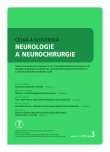-
Medical journals
- Career
The Effect of the Region of Interest Choice on the Results of Pyramidal Tract Representation by Diffusion Tensor Imaging – a Case Report
Authors: R. Bartoš 1,2; A. Malucelli 1,2; P. Bartoš 2; D. Adámek 3; J. Zárubová 4; M. Sameš 1
Authors‘ workplace: Neurochirurgická klinika UJEP a Krajská zdravotní a. s., Masarykova nemocnice v Ústí nad Labem, o. z. 1; ICRC – Mezinárodní centrum klinického výzkumu, FN u sv. Anny v Brně 2; Radiodiagnostické oddělení, Krajská zdravotní a. s., Masarykova nemocnice v Ústí nad Labem, o. z. 3; Neurologická klinika 2. LF UK a FN v Motole, Praha 4
Published in: Cesk Slov Neurol N 2015; 78/111(3): 354-358
Category: Case Report
doi: https://doi.org/10.14735/amcsnn2015354Overview
In our short report, we show the relative nature of pyramidal tract representation using Diffusion Tensor Imaging in a patient with a precentral gyrus glioma and we discuss the factors that may affect tract reconstruction. We believe that, so far, inadequate attention has been paid in the published literature to the region of interest selection even though this is the key determinant of the imaging outcome.
Key words:
glioma – navigation – tractography – electric cortical stimulation
The authors declare they have no potential conflicts of interest concerning drugs, products, or services used in the study.
The Editorial Board declares that the manuscript met the ICMJE “uniform requirements” for biomedical papers.
Sources
Literatura
1. Kamada K, Sawamura Y, Takeuchi F, Kawaguchi H, Kuriki S, Todo T et al. Functional identification of the primary motor area by corticospinal tractography. Neurosurgery 2005; 56 (Suppl 1): 98 – 109.
2. Seo JP, Jang SH. Different characteristics of the corticospinal tract according to the cerebral origin: DTI Study. Am J Neuroradiol 2013; 34(7): 1359 – 1363.
3. Mandelli ML, Berger MS, Bucci M, Berman JI, Amirbekian B, Henry RG. Quantifying accuracy and precision of diffusion MR tractography of the corticospinal tract in brain tumors. J Neurosurg 2014; 121(2): 349 – 358. doi: 10.3171/ 2014.4.JNS131160.
4. Okada T, Mikuni N, Miki Y, Kikuta K, Urayama S, Hanakawa T et al. Corticospinal tract localization: integration of diffusion ‑ tensor tractography at 3 – T MR imaging with intraoperative white matter stimulation mapping – preliminary results. Radiology 2006; 240(3): 849 – 857.
5. Berman JI, Berger MS, Chung S, Nagarajan SS, Henry RG.Accuracy of diffusion tensor magnetic resonance imaging tractography assessed using intraoperative subcortical stimulation mapping and magnetic source imaging. J Neurosurg 2007; 107 : 488 – 494.
6. Bello L, Gambini A, Castellano A, Carrabba G, Acerbi F. Motor and language DTI Fiber Tracking combined with intraoperative subcortical mapping for surgical removal of gliomas. NeuroImage 2008; 39(1): 369 – 382.
7. Zolal A, Hejčl, Vachata P, Bartoš R, Humhej I, Malucelli Aet al. The use of diffusion tensor images of the corticospinal tract in intrinsic brain tumor surgery; a comparison with direct subcortical stimulation. Neurosurgery 2012; 71(2): 331 – 340. doi: 10.1227/ NEU.0b013e31825b1c18.
8. Ostrý S, Belšan T, Otáhal J, Beneš V, Netuka D. Is intraoperative diffusion tensor imaging at 3.0T comparable to subcortical corticospinal tract mapping? Neurosurgery 2013; 73(5): 797 – 807. doi: 10.1227/ NEU.0000000000000087.
Labels
Paediatric neurology Neurosurgery Neurology
Article was published inCzech and Slovak Neurology and Neurosurgery

2015 Issue 3-
All articles in this issue
- The Effect of Supratentorial Grade II Gliomas Growth Rate on their Prognosis
- Etiology of Parkinson’s Disease – New Advances and New Challenges
- Verbal Fluency Tests – Czech Normative Study for Older Persons
- Addenbrooke’s Cognitive Examination – Approximate Normal Values for the Czech Population
- Current State of Art of the Therapy of WHO Grade III Gliomas in the Czech Republic
- The Use of the QUALID Scale for Evaluating the Quality of Life in Patients with Late‑stage Dementia in the Czech Republic
- Surgical Treatment Outcomes in Patients with „Pure“ Traumatic Epidural Hematoma
- Neuropsychological Performance with First‑ episode of Schizophrenia
- Kennedy’s Disease in the Neuromuscular Centre in Bratislava
- Occurence of Peripheral Primitive Neuroectodermal Tumor within Spinal Nerve Root – a Case Report
- Brain Abscess as the First Clinical Manifestation of Hereditary Hemorrhagic Telangiectasia – Three Case Reports
- The Effect of the Region of Interest Choice on the Results of Pyramidal Tract Representation by Diffusion Tensor Imaging – a Case Report
- Air Embolism of the Brain – a Case Report
- Diagnosis of Epileptic Seizures
- Spinal Shock – from Pathophysiology to Clinical Manifestation
- Biomarkers of Multiple Sclerosis – Current Options and Future Perspectives
- Posterior Fossa Abscess with Obstructive Hydrocephalus in a Child with Occipital Dermal Sinus with Dermoid Cyst Manifestation – a Case Report
- Czech and Slovak Neurology and Neurosurgery
- Journal archive
- Current issue
- Online only
- About the journal
Most read in this issue- Addenbrooke’s Cognitive Examination – Approximate Normal Values for the Czech Population
- Spinal Shock – from Pathophysiology to Clinical Manifestation
- Diagnosis of Epileptic Seizures
- Verbal Fluency Tests – Czech Normative Study for Older Persons
Login#ADS_BOTTOM_SCRIPTS#Forgotten passwordEnter the email address that you registered with. We will send you instructions on how to set a new password.
- Career

